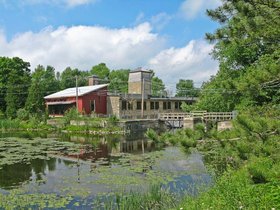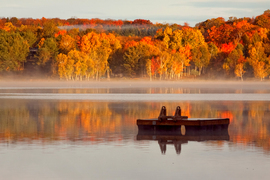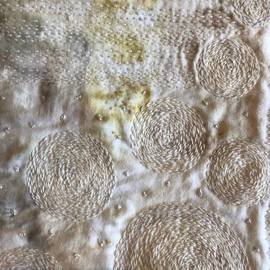From Industry to Inspiration - History & Restoration of the Alton Mill
Settled in the mid-1800s on the banks of Shaw’s Creek (a tributary of the Credit River), the village of Alton was once a thriving industrial centre. Now part of the Town of Caledon, Alton still boasts many historic buildings. The two remaining 19th century stone mills in Alton are the Millcroft Inn and Spa, and the Alton Mill. A provincially designed heritage industrial complex, the Alton Mill is also listed on the Canadian Register of Historic Places.

In 1857 the provincial land surveyor (Charles Wheelock) surveyed Shaw’s Creek and identified nine mill privileges (eight of which were eventually developed).
William Algie purchased mill privileges #5 and 6 from Kenneth Chisholm in 1880, and privilege #4 from Alexander Dick in 1893. The existing mill complex and dam are situated on privilege #5, and the mill pond is situated on privilege #6 (as well as part of #5). Privilege #4 is located in Shaw’s Creek, directly west of Amelia Street.
Beaver Knitting Mill
Local industrialist and philanthropist William Algie built the complex in 1881 and established the Beaver Knitting Mill. The Beaver Knitting Mill was renowned across Canada for the production of fleece-lined long underwear.
Great Alton Flood of 1889
During the great Alton Flood of 1889, the weir and damn built by Algie held significantly longer than others along Shaw’s Creek, resulting in a much lower loss of life than could otherwise have been expected by a disaster of such magnitude. The Mill was flooded and its foundations damaged, but otherwise miraculously survived the Great Alton Flood relatively unscathed.

Although the Mill survived the great Alton Flood of 1889, it wasn’t so lucky in 1908 when the Mill was struck by a disastrous fire. The fire reduced the original three-and-a-half storey limestone building to its present two stories and shed roof. The fourth storey of the water tower was also destroyed and rebuilt in poured concrete with a hip roof clad in cedar shake. Prior to 1913 and possibly associated with the reconstruction of the mill after the fire, a new two-storey stone addition was built on the east end of the old mill.
Dods Knitting Company
Following William Algie’s death in 1915, the Beaver Knitting Mill was acquired by the Dods Knitting Company, which also owned Alton’s “Upper Mill” (the current location of the Millcroft Inn & Spa). The Great Depression and changing textile trends resulted in the closure of the Beaver Knitting Mill in 1932, with all machinery moved to the Dods’ Orangeville textile mill.

In 1935 the Mill was sold to Frederick N. Stubbs, owner of the Western Rubber Company. Stubbs converted the Mill to manufacture rubber products, including balloons for Disney, rubber gloves and condoms for Canadian servicemen during the Second World War. The Mill remained in operation until 1982 and was the longest-running water-powered mill on the upper Credit River system.
Restoration

Hit by the early ‘90s recession, Jack’s sons Jordan and Jeremy Grant, who took over management of the company at the time, struggled to find either a suitable use or a buyer for the property. The highest offer they received was $150,000 and the real estate agent advised them to demolish the building as the underlying land had a higher value. But for them, the attraction was the building and they hung on, concentrating on other priorities to rebuild their business. Finally, in 1999, Jeremy was approached by a local woodworker, Carl Borgström, who said he would love to have his shop in the mill and thought there would be demand for studios by other craftspeople and artists. So the Grants worked with Carl to convert the east section of the mill, which was newer and in better condition, into a woodworking shop and six studios. The first tenants moved in at the end of the year.

But the numbers didn’t work - the estimated cost of the restoration was far greater than could be supported by the income that could be generated by the projected uses. Instead of dropping the idea, the Grants pursued public funding to help bridge the economic gap. In 2005, after having had the building designated under the Ontario Heritage Act and placed on the Register of Historic Places in Canada, Seaton and Headwaters Arts obtained commitments of up to $774,500 from the provincial Rural Economic Development (RED) fund and up to $1,000,000 from the Commerical Heritage Properties Incentive Fund (CHPIF), administered by Parks Canada.

Seaton Group, whose real estate development business had recovered by that point, bit the bullet and committed to pay the rest of the cost to complete the project, then estimated at $4.8 million including the pond and the Annex. One of Parks’ Canada's requirements was that the rehabilitation process be done in adherence with the "Standards and Guidelines for the Conservation of Historic Places in Canada", which are very onerous. In order to ensure that this condition be met and to establish high standards for the design of the project, the Grants retained Catherine Nasmith to act as architect. Cathy’s primary architectural practice to that point had been custom homes, but she was also a tireless advocate for heritage preservation, then serving as the Vice-President (subsequently President) of the Architectural Conservancy of Ontario ("ACO") and publisher of Built Heritage News. Cathy leaped at the opportunity - this was a chance to put what she was preaching into practice. Cathy in turn introduced the Grants to J. D. Strachan and Associates, a construction firm specializing in heritage restoration that she knew through the ACO.

Construction began in the fall of 2006 and continued until the spring of 2009. The first step was an extensive abatement program to remove black mould, animal feces and asbestos. It required sealing the building and creating negative pressure while blasting the mould with dry ice pellets.

There was a constant battle against water entering the lower level, which ultimately resulted in an intricate system of exterior and underfloor drains leading via one-way valves into the millrace. The stonework required extensive repointing, and to stem further deterioration of the Annex, it was decided to restore its walls as well, with a concrete beam poured along the top to help weatherproof and stabilize them. The top of the chimney had to be removed for safety reasons and the budget didn't permit it to be fully replaced. So careful measurements and photographs were taken for possible future restoration, and it was capped off at a lower level.

Floodproofing requirements meant that non-operating metal windows were installed on the lower level - designed to withstand the pressure of floodwaters. Floodproofing also required the Waterfall Courtyard walls to be repointed and grouted in order to ensure they would be sound enough to act as a flood-protection wall. As the driveway dips down and is predicted to be inundated in the event of a catastrophic flood, a new bridge had to be installed across the river in order to provide safe egress at all times.

Careful attention has also been given to protecting both the historic character of the site and the environment. After being presented with precedents from other jurisdictions, the Town of Caledon bent its rules and permitted parking areas tucked into the woods connected by steeper-than-normal ramps. This allowed the sloping terrain to remain largely undisturbed, and extensive areas of trees to be preserved. The section of the Bruce trail that runs through the site was relocated to maximize hikers' experience of the site. Stormwater was directed to a huge underground infiltration pit to filter and absorb the water before it gets to Shaw's Creek.















